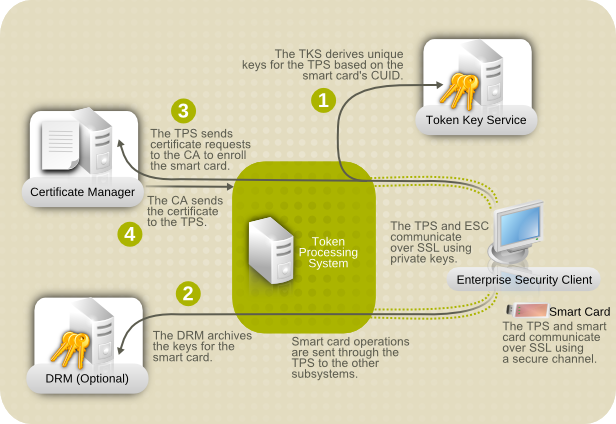此内容没有您所选择的语言版本。
1.2. Red Hat Certificate System and the Enterprise Security Client
Red Hat Certificate System creates, manages, renews, and revokes certificates and keys. For managing smart cards, the Certificate System has a token management system to generate keys, create certificate requests, and receive certificates.
Two subsystems — the Token Key Service (TKS) and Token Processing System (TPS) — are used to process token-related operations. The Enterprise Security Client is the interface which allows the smart card and user to access the token management system.
A total of four Certificate System subsystems are involved with managing tokens, two for managing the tokens (TKS and TPS) and two for managing the keys and certificates within the public-key infrastructure (CA and DRM).
- The Token Processing System (TPS) interacts with smart cards to help them generate and store keys and certificates for a specific entity, such as a user or device. Smart card operations go through the TPS and are forwarded to the appropriate subsystem for action, such as the Certificate Authority to generate certificates or the Data Recovery Manager to archive and recover keys.
- The Token Key Service (TKS) generates, or derives, symmetric keys used for communication between the TPS and smart card. Each set of keys generated by the TKS is unique because they are based on the card's unique ID. The keys are formatted on the smart card and are used to encrypt communications, or provide authentication, between the smart card and TPS.
- The Certificate Authority (CA) creates and revokes user certificates stored on the smart card.
- Optionally, the Data Recovery Manager (DRM) archives and recovers keys for the smart card.
Figure 1.1. How Certificate System Manages Smart Cards
As Figure 1.1, “How Certificate System Manages Smart Cards” shows, the TPS is the central hub in the Red Hat Certificate System token management system. The token communicates with the TPS directly. The TPS then communicates with the TKS to derive a set of unique keys that can be used for TPS-token communication (1). When the smart card is enrolled, new private keys are created for the token; those keys can be archived in a DRM (2), if key archival is configured. The CA then processes the certificate request (3) and issues the certificates to store on the token. The TPS sends those certificates back to the Enterprise Security Client (4), and they are saved to the token.
The Enterprise Security Client is the conduit through which TPS communicates with each token over a secure HTTP channel (HTTPS), and, through the TPS, with the Certificate System.
To use the tokens, the Token Processing System must be able to recognize and communicate with them. The tokens must first be enrolled to populate the tokens with required keys and certificates and add the tokens to the Certificate System. The Enterprise Security Client provides the user interface for users to format and manage smart cards.
